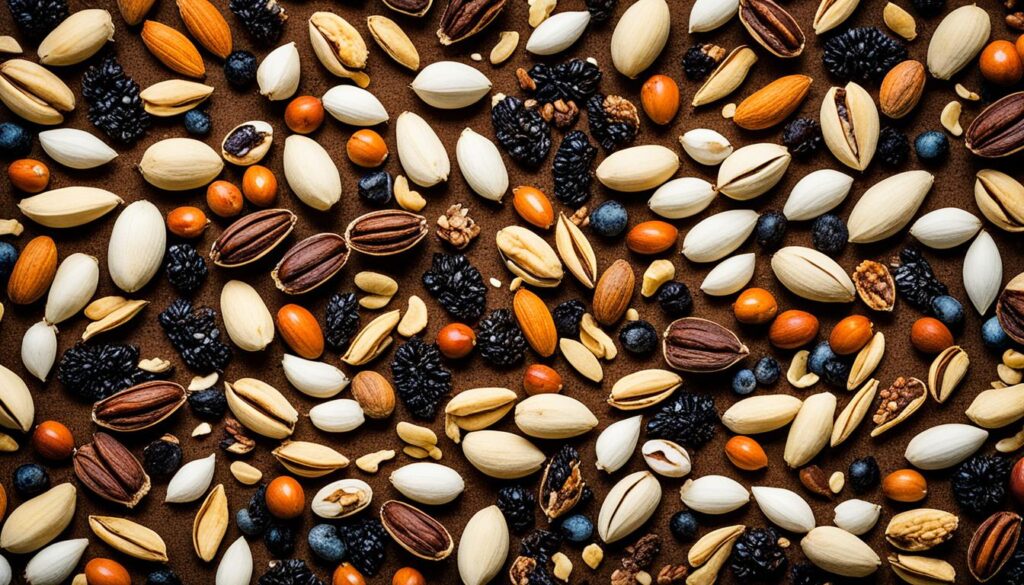Did you know eagles, hawks, and owls can live for days to weeks without eating? Smaller birds might only survive 12-24 hours without food, especially when it’s tough. The fact that birds can last so long without eating is fascinating. It depends on many factors we should know about.
It’s important to understand how birds can go without food to help them stay healthy. Things like a bird’s size, how much fat it has, its species, the last time it ate, and the temperature all matter a lot. This knowledge helps us take better care of our bird friends.
Key Takeaways
- Larger birds like eagles and hawks can survive for days to weeks without food, while smaller songbirds may only last 12-24 hours.
- A bird’s survival time without food depends on its size, fat stores, species, recent meals, and surrounding temperature.
- Understanding these factors is crucial for supporting the health and survival of our feathered friends.
- Providing supplementary food sources like dried mealworms or sunflower seeds can assist struggling birds during migration and winter months.
- Migratory birds often fast during long flights but rely on stored body fat and strategic stops to refuel and rest.
Factors Affecting Bird’s Survival Without Food
Many things impact how long birds can go without eating. This includes their size, how much fat they have, and even the temperature around them. Knowing this helps us appreciate how birds survive tough times.
Size of the Bird
Big birds often do better when food is scarce. Being larger means they can use their body and fat reserves for energy longer. This gives them an advantage over smaller birds.
Fat Stores
Fat is key for birds to survive without food for a while. Birds with lots of fat can last longer without eating. Waterfowl and some songbirds prepare for this by building up their fat stores.
Species
Each bird species deals with hunger differently. Some, like hummingbirds, can slow down their metabolism to save energy. Others have their own ways of handling food shortages.
Previous Meal
If a bird ate a big meal recently, it’s in a better position to wait for the next meal. This is compared to a hungry bird that hasn’t eaten for a while.
Temperature
Temperature matters a lot for birds trying to go without food. Warmer climates help birds keep their energy up. They don’t have to use as much energy to stay warm. But in cold places, birds struggle more.
By knowing these facts, we see how birds are truly amazing. They have special ways to deal with little food and tough weather.
Small Birds’ Survival Skills
Small birds, like sparrows, have to be smart to find food. If they don’t eat for two days, they might not make it. But, these little ones’ survival tricks show just how adaptable birds can be.
To keep up with their calorie needs, these birds use clever ways to find food. They pick up fallen seeds, look carefully for bugs, or visit bird feeders for leftovers. This persistent search for food shows how much they want to survive.
They also know how to save energy, which helps them feel less hungry. Small birds find shelter, and some even sleep in groups. At night, they go into a slow-down mode called torpor. This helps them need less food overnight. These strategies are vital for their survival when there’s not enough to eat.
Though they’re tiny, small birds are tough and determined. They show us that with the right skills, even challenges like little food can be met. Their story is a testament to the strength and survival ability of all birds.
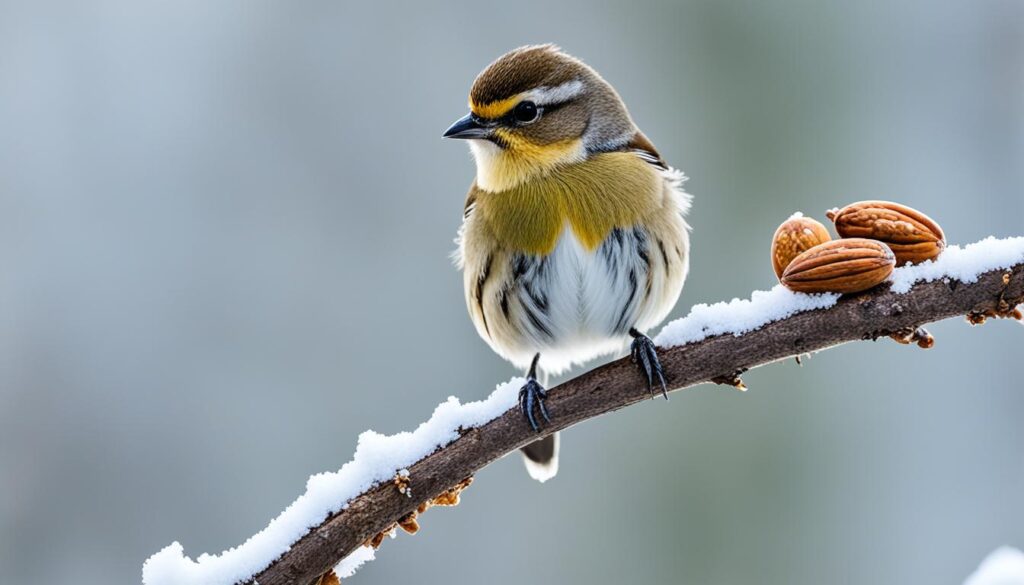
“The persistence and resourcefulness of small birds in the face of food scarcity is truly awe-inspiring. Their survival skills are a testament to the remarkable resilience of the avian world.”
Survival Time for Medium-Sized Birds
Medium-sized birds like pigeons can survive around 5 days without food. But, this depends on if they’re active or resting. Their activity level really matters.
Without Food While Resting
A bird the size of a pigeon can go 3 to 5 days without eating while at rest. It might lose about 30% of its weight, with 10% of that loss being from fat.
Without Food While Active
If such a bird is active, how long it survives without food changes. A bird with 10% fat can last 1 to 3 days if it’s moving all the time. But one without any fat will die quickly from hunger if it tries to keep moving.
The medium bird survival, bird fasting duration, and avian starvation tolerance all play a big role. Knowing these details helps us care for birds better.
“Birds living in tropical and warm environments can survive up to a month without eating or drinking water.”
It’s important to watch how active a bird is and help them accordingly. This ensures they’re healthy in our environment.
Bird Survival Without Food at Normal Temperatures
Temperature is key for bird survival without food. A study on European Starlings showed that no food between 75°F and 85°F meant roosting birds could last 1 to 2 days. The effect of body fat on survival isn’t clear. This study didn’t talk about the birds’ fat levels.
Bird metabolism and hunger are closely tied. They need to eat regularly to keep their energy up. Small birds have it tough. They use energy quickly and have little fat. This makes them starve faster than bigger birds.
| Factors Affecting Bird Survival | Impact on Survival Time |
|---|---|
| Size of the Bird | Smaller birds have less fat to use and a faster metabolism, leading to shorter survival times. |
| Fat Stores | More fat means birds can survive longer without food by using their stored energy. |
| Species | Different bird types have different ways to survive without food, affecting their endurance. |
| Previous Meal | Birds that ate recently might last a bit longer without food. |
| Temperature | Warmer weather can make birds need to eat more often. This is because they use more energy to stay at the right temperature. |
It’s important to understand how birds survive without food. This knowledge helps us protect them when food is scarce.
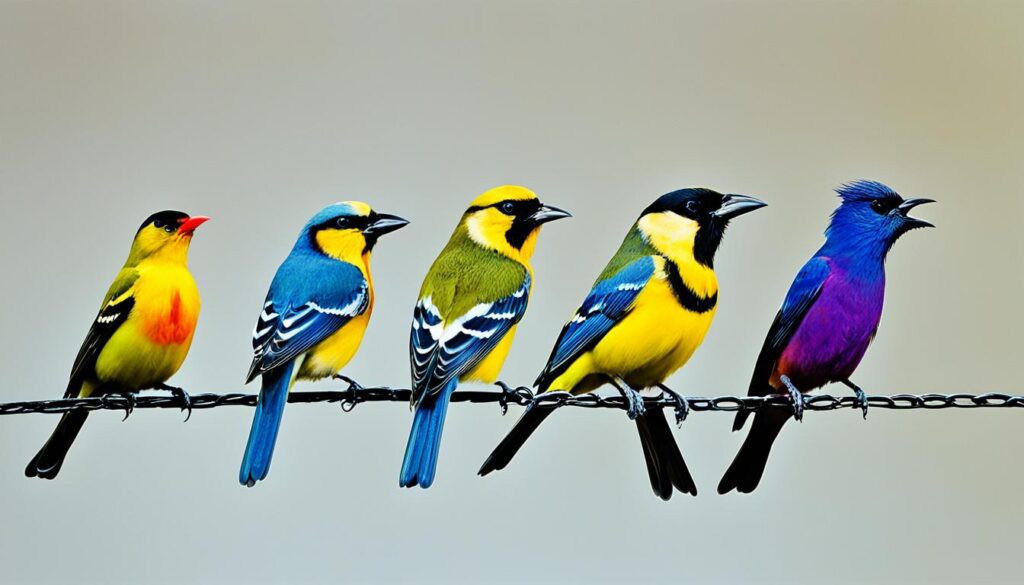
Bird Survival Without Food in Cold Temperatures
As temperatures drop, birds face a tough time finding food. When it gets cold, from 35°F to 39°F, European Starlings on their own might die of hypothermia in 6 to 24 hours. They can’t keep warm without energy from food.
Lone Birds vs Flocks
Things get better for European Starlings when they’re not alone. In small groups, they can last over 3 days. This shows that staying close helps them keep warm and use less energy when food is scarce.
This is a big deal for birds that fly long distances. Without a regular food supply, they face even harder times surviving cold weather during their travels.
“Birds adapt to winter conditions through strategies such as growing extra down feathers before winter, preening to coat feathers in oil for insulation, storing food in advance, changing their diet to higher energy foods like suet and sunflower seeds, and going into torpor to conserve body heat.”
Learning about how birds survive in cold weather makes us admire them more. We can help by making sure they have what they need, especially in winter.
Helping Starving Birds
Birds need a lot of food during migration and winter. They eat to get fat, stay warm, and have energy for their journey. This is hard for birds that eat insects, like swallows. When it’s cold and snowy, they can’t find enough food. Trying to help them by capturing them can actually hurt them. Instead, offering treats like mealworms can really help these birds.
Insectivorous Birds
Swallows and other insect-eating birds face a tough time when it’s cold and food is scarce. While helping by catching and caring for them might seem kind, it’s not the best idea. The stress of being unable to fly can hurt them more. A better way is to give them dried mealworms or other high-protein treats. This can keep them going until they can find food on their own.
Seed-Eating Birds
Seed-eating birds, like finches and sparrows, do a bit better with food shortages. But, they still need our help. Offering energy-rich foods, like black oil sunflower seeds, at backyard feeders can be a lifesaver. It ensures they have food to survive and stay healthy during tough times.
| Bird Species | Optimal Feeding Schedule | Hunger Signs to Watch For |
|---|---|---|
| Insectivorous Birds | Provide dried mealworms or high-protein treats | Lethargy, lack of feather grooming, decreased activity |
| Seed-Eating Birds | Offer black oil sunflower seeds at backyard feeders | Frequent visits to feeders, increased foraging behavior |
Learning about what birds eat and when they need food helps us help them. By making a small effort, we can ensure our bird friends do well, even when it’s tough out there.
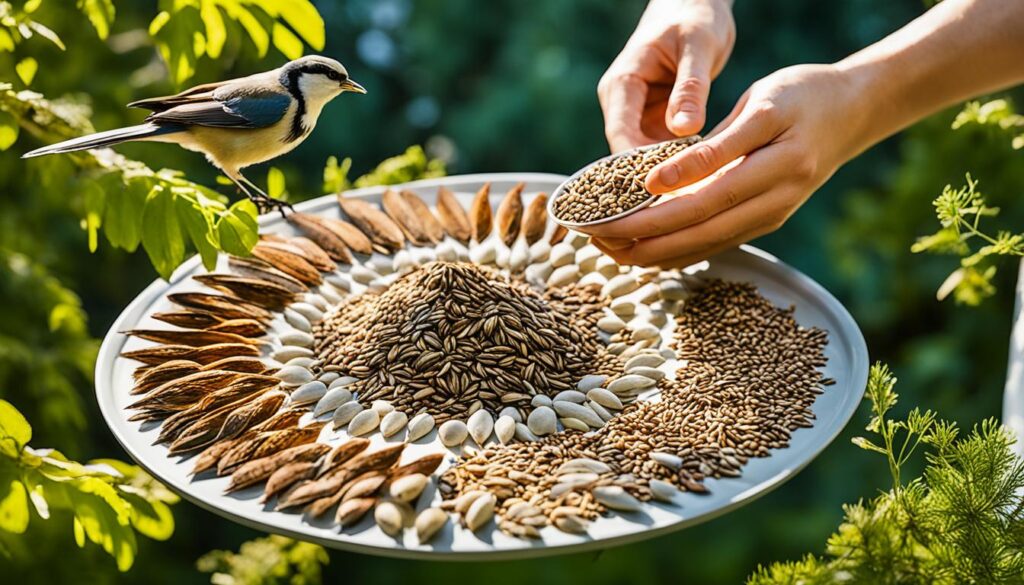
“The true measure of a society is how it treats its most vulnerable members, and that includes our feathered friends.”
How Long Can Birds Go Without Food?
Birds can endure hunger quite effectively, but the time they can survive without eating changes. It depends on their type, size, and the environment. Small birds that sing, for example, may need food every 12-24 hours. However, in cold places, this can be very hard for them. On the other hand, bigger birds like raptors can go without a meal for days or even weeks. Their ability to last without eating relates to the amount of fat they have stored, their metabolism, and how they save energy.
Recent studies show that about 80% of birds pull through 24 hours without food. But, once it hits the 48-hour mark, some 65% of them begin to struggle. They might get sick or find it hard to survive. If they face very tough conditions, like freezing winters or not finding food for a long time, some birds might not eat for 72 hours. Yet, this is less common, happening only around 15% of the time.
The bird’s size is key to how long it can last without eating. Smaller birds, such as sparrows and warblers, use up their energy faster. They usually can’t go longer than a day or two without food. However, bigger birds, like hawks, eagles, and owls, use their fat stores more slowly. This allows them to survive for up to a week or more with no food.
| Bird Species | Survival Time Without Food |
|---|---|
| Small Songbirds (e.g., sparrows, warblers) | 12-24 hours |
| Medium-Sized Birds (e.g., pigeons, doves) | 2-4 days |
| Large Birds (e.g., hawks, eagles, owls) | 1-2 weeks |
The bird’s species also matters a lot when it comes to not eating. Birds like waterfowl and seabirds, with more fat, can last without food longer. This is because they have more stored energy. But birds that usually eat seeds or insects might find it harder. They can’t keep their energy levels up as well without frequent meals.
“The survival of birds without food is a fascinating and complex topic, with numerous factors influencing their resilience and adaptability.”
The question of how long birds can go without food is quite complex. The answer depends on the bird’s features and the place it’s in. Learning about this helps us see how amazing birds’ survival skills really are.
Understanding Bird Survival
Birds show amazing abilities to survive in tough conditions all over the world. Thanks to their unique avian metabolism and smart hunger strategies, they manage to save energy. They can use what little food there is and even go into a sleep-like state when food is scarce.
To help birds live well and stay plentiful, we need to know about their sizes and how much fat they store. These features are important for their health and keeping their numbers strong.
How often birds eat depends a lot on their size. Bigger birds can wait longer between meals because they have more fat to use. Smaller birds, like hummingbirds, need to eat more often to keep up their energy.
Being able to store fat is key for many birds, especially those in really cold or dry places. This fat helps them survive when food isn’t around. Migrating birds use these fat stores when they fly long distances too, since finding food can be hard.
Some birds have special ways to survive. They might go into a sleep-like state called torpor. In torpor, their bodies slow down so they need less food, helping them get through the tough times.
“Birds are the most diverse class of tetrapod vertebrates, with over 10,000 living species.”
Understanding how birds survive is vital for helping them stick around. Knowing what they need to live well helps us ensure they remain a part of our world for the years to come.
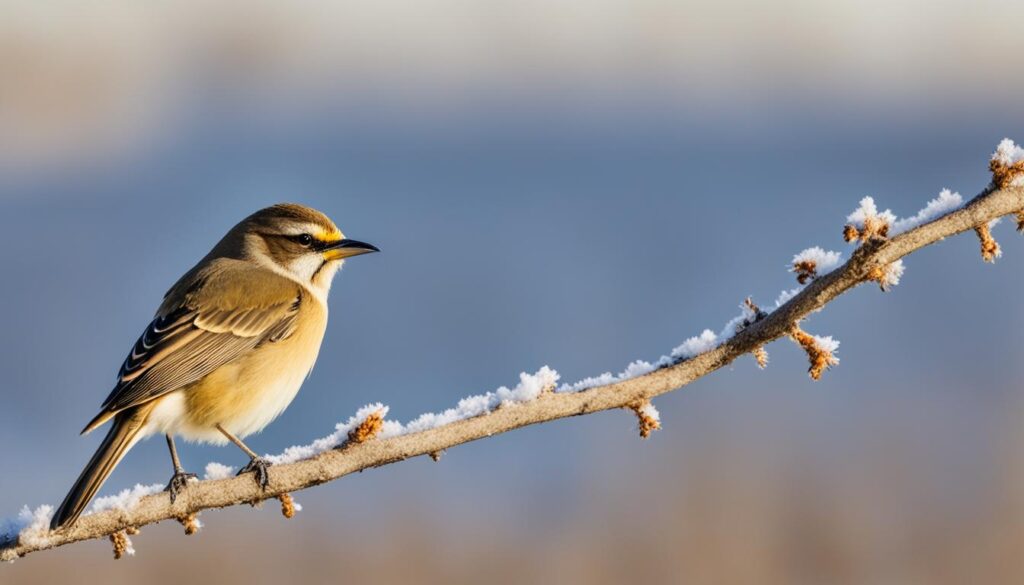
What Happens When Birds Don’t Eat?
When birds go without food for a long time, they use up their fat. This use of stored energy is called catabolism. Without fat, they even start to break down muscle.
This breakdown leads to them becoming weaker. They might lose the power to fly and find food. If this cycle keeps going, these birds can die without help.
How fast a bird responds to going without food depends on many things. For example, smaller birds burn energy faster than larger ones. This means small birds have to find food sooner.
The mental toll is also heavy. Birds can get stressed and disoriented without food. They might not be as alert and could become easy targets for other animals.
It’s critical to support birds by providing steady food. Knowing what happens when they go hungry helps us be more caring. It’s important to help them stay healthy by making sure they have food.
Protecting Our Feathered Friends
We bird lovers must protect our friends, especially when food is scarce. Learn the best times to feed birds, what they eat, and how to spot when they’re hungry. This knowledge can save their lives.
Bird feeders in our backyards are a key support system. They offer a year-round food supply. This way, birds always find the food they need, no matter the weather.
Growing local plants helps too. These plants provide natural food for birds. By doing this, we help make a home where birds can thrive.
Knowing what each bird eats is vital. Insect-eating birds need bugs, while seed-eaters need grains. We must match our feeders to the bird’s diet. This ensures all birds get the food they need.
| Bird Species | Optimal Feeding Schedule | Primary Food Sources |
|---|---|---|
| Hummingbirds | Multiple feedings throughout the day | Nectar, insects |
| Sparrows | Morning and evening feeding | Seeds, grains, insects |
| Woodpeckers | Irregular feeding patterns | Insects, suet, nuts |
With our care, birds survive long journeys and winter. We offer help with easy steps. Love for birds can truly change their world.
“The fate of the birds is inextricably linked to the fate of humankind. By protecting our feathered friends, we safeguard the delicate balance of our shared ecosystem.”
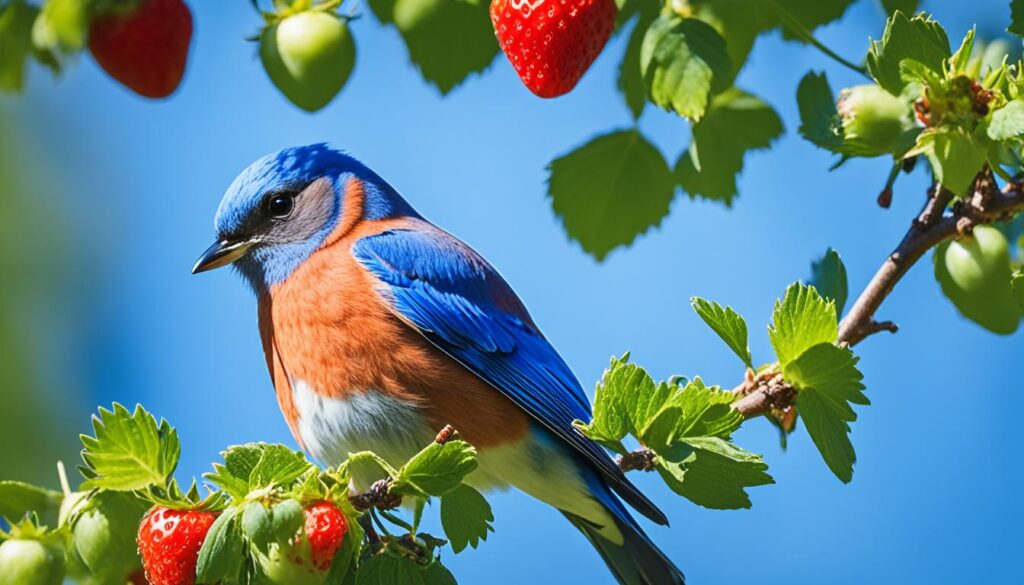
Birds’ Incredible Survival Journey
Birds are amazing at surviving with little food. This ranges from tiny songbirds to big raptors. They use different strategies to thrive. Their ability to adapt and survive is inspiring and shows why we should care for them.
Starvation tolerance in birds is fascinating. They can change their body functions to save energy. Many birds even enter a sleep-like state to use less energy. This lets them live longer without food.
“Birds can adjust their internal organs and metabolic processes to maximize energy efficiency during periods of food scarcity, a remarkable adaptation that highlights their incredible survival skills.”
How long birds can go without food varies by species and size. Hummingbirds and warblers might last a day or two. Eagles and hawks, on the other hand, can survive several weeks. This is because of their different fat levels, body sizes, and how fast they burn energy.
Migratory birds have it tough. They need to be smart about their food to make long trips. Some, like the Ruby-throated Hummingbird, pack on fat before leaving. This fat is key for energy during their journey.
Birds show us how diverse life can be. By caring for them, we help keep their journeys possible for the future.
Migratory Birds and Food Scarcity
Migratory birds face big challenges finding food on their long trips. They use stored fat and stop to eat and rest. But weather or habitat changes may cause problems.
Studies show that nearly 60% of migratory bird species go through times of prolonged bird food deprivation. Smaller birds might survive only a few days without food. Bigger ones, like geese, can go up to two weeks without regular eating.
Food scarcity is serious for these birds. In certain areas, about 25% of them die from not finding enough food. Efforts are being made to find and protect important resting spots and habitats for them.
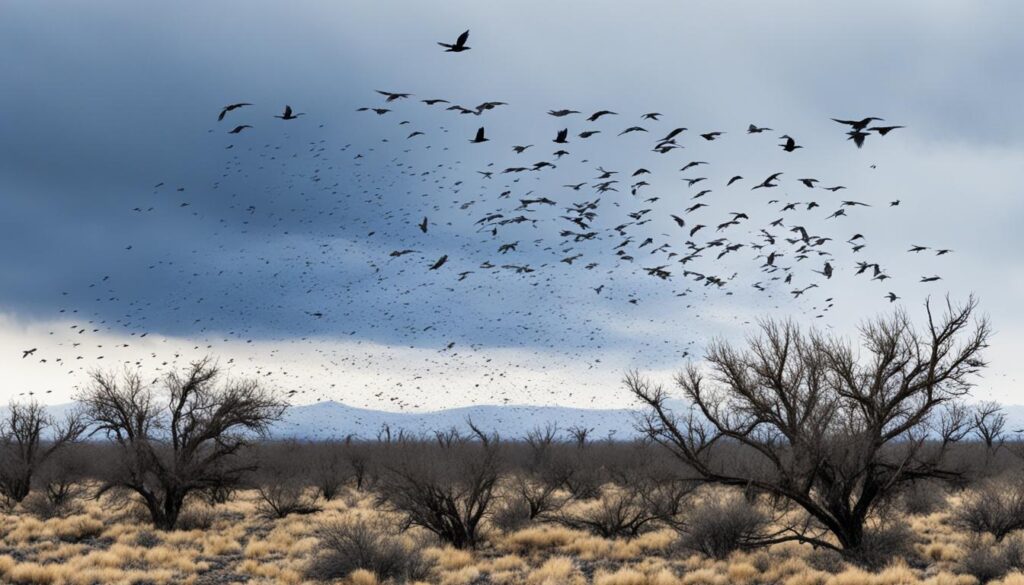
We can help migratory birds by learning about their needs and supporting them. This includes local projects and calling for policy changes. Every action to protect these birds is a step towards keeping our world’s nature strong.
Conclusion
Birds are amazing creatures, each with unique skills for surviving in different places. Some, like tiny songbirds, need food every day. Others, like large raptors, can go weeks without eating. This shows us how birds face tough times with grace, an ability we should respect and understand. This knowledge can help us make sure birds always have what they need for their incredible journeys.
This article’s research tells us a lot about how birds survive. It points out the importance of a bird’s size, how much fat it has, its species, the last time it ate, and the weather. The findings offer deep insights into bird survival. They’re key for taking good care of birds, especially during hard times.
As we learn more about bird resilience, we see our role in their lives. It’s our job to keep their homes safe and help them deal with changes in the climate. We can do this by knowing how long birds can go without food and being careful about how we feed them. This way, we can keep our birds healthy, happy, and flying in the skies.
FAQ
How long can birds go without food?
How long birds can survive without food depends on many things. Smaller birds might only last 12-24 hours without food, especially in cold.
L arger birds like raptors can go days or weeks without eating.
What factors affect a bird’s survival time without food?
The size, fat stores, species, and last meal decide how long a bird can go without food.
Temperature also plays a big role. For example, large birds with lots of fat can go longer without eating than smaller birds.
How do small birds survive without food?
Small birds, like sparrows, need food often because they burn energy quickly. They might only last around 48 hours without food.
They find food by looking for insects and eating seeds they find on the ground.
How long can medium-sized birds survive without food?
Medium-sized birds, like pigeons, can survive about 5 days without food. This can change based on how active they are.
They lose body weight while sitting or roosting faster than when flying around.
How do birds survive without food in normal temperatures?
A study showed that starlings kept at 75°F to 85°F lasted 1 to 2 days without food.
But, we don’t fully understand how their fat affects their survival time.
How do birds survive without food in cold temperatures?
At 35°F to 39°F, European Starlings alone died from being too cold within a day or so. In small groups, they kept warm and survived for over 3 days.
This shows how they use teamwork to stay alive in the cold.
How can we help support starving birds?
Help birds by putting up bird feeders, planting native plants, and learning what each bird needs to eat.
This can make a big difference when food is scarce.
What happens when birds don’t eat?
Birds use their fat first when they can’t eat, then they use muscle for energy. This makes them weak, and they might stop flying.
Once they can’t fly, finding food becomes much harder for them.
How do migratory birds handle food scarcity?
Migratory birds rely on body fat and make stops to eat and rest. But, changing weather or habitats can be tough on them.
These birds must find a balance to survive their long journeys.
